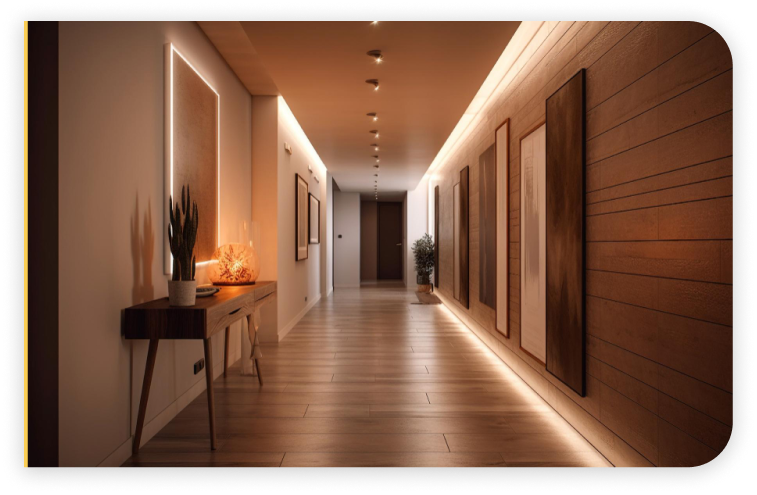February 13, 2024
Drywall is a popular building material used in the construction and renovation of homes and offices. While it’s known for its versatility and ease of installation, it’s not immune to problems. From cracks and holes to uneven surfaces, drywall issues can be a headache for homeowners. In this blog, we’ll explore some common drywall problems and provide practical tips for troubleshooting and solving them.
Drywall Cracks:
- Causes: Cracks in drywall can occur due to settling, temperature changes, or structural movement.
- Solution: For small cracks, use a joint compound to fill them in. For larger cracks, consider using mesh tape to reinforce the repair. Sand the area once the compound is dry, and repaint if necessary.
Nail Pops:
- Causes: Shifting or settling of the house can cause nails to pop out, creating bumps on the wall.
- Solution: Hammer the popped nail back in, ensuring it’s flush with the wall. Apply a coat of joint compound over the area, sand it smooth once dry, and repaint.
Holes and Dents:
- Causes: Accidental impacts or furniture movements can result in holes or dents.
- Solution:oSolution: Small holes can be filled with spackle, while larger holes may require a patch. Sand the patched area, prime, and repaint for a seamless finish.
Uneven Surfaces:
- Causes: Poor installation or moisture issues can lead to uneven drywall surfaces.
- Solution: Sand down high spots and use joint compound to fill in low areas. Repeat the process until the surface is smooth. Properly prime and paint to finish.
Bubbling or Blistering Paint:
- Causes: Moisture issues, improper priming, or poor-quality paint can lead to bubbling or blistering.
- Solution: Identify and fix the source of moisture. Scrape off the affected paint, patch any damaged areas, prime, and repaint using a high-quality paint.
Tape Bubbles:
- Causes: Improper application of drywall tape or drying too quickly can result in visible bubbles.
- Solution: Cut out the bubbled tape, apply a thin coat of joint compound, and re-tape. Feather the edges with additional compound, sand, and repaint.
Stains and Discolouration:
- Causes: Water leaks or other environmental factors can lead to stains or discolouration.
- Solution: Address the source of the issue first. For stains, apply a stain-blocking primer before repainting. For discolouration, consider a fresh coat of paint to rejuvenate the appearance.
Sagging Drywall:
- Causes: Over time, gravity can cause drywall to sag.
- Solution: Secure the sagging area with screws, making sure they penetrate the framing. Add additional screws along the edges and seams. Apply joint compound to smooth the surface, sand, and repaint.
Dealing with drywall problems doesn’t have to be a daunting task. With the right knowledge and tools, many issues can be resolved without the need for professional assistance. Regular maintenance and prompt repairs can help keep your drywall in excellent condition, ensuring a smooth and visually appealing finish for your home or office.
February 13, 2024
Your Go-To Guide for Drywall Distress: Solutions for Every Scenario
Drywall is a popular building material used in the construction and renovation of homes and offices. While it’s known for its versatility and ease of installation, it’s not immune to problems. From cracks and holes to uneven surfaces, drywall issues can be a headache for homeowners. In this blog, we’ll explore some common drywall problems and provide practical tips for troubleshooting and solving them.
Drywall Cracks:
- Causes: Cracks in drywall can occur due to settling, temperature changes, or structural movement.
- Solution: For small cracks, use a joint compound to fill them in. For larger cracks, consider using mesh tape to reinforce the repair. Sand the area once the compound is dry, and repaint if necessary.
Nail Pops:
- Causes: Shifting or settling of the house can cause nails to pop out, creating bumps on the wall.
- Solution: Hammer the popped nail back in, ensuring it’s flush with the wall. Apply a coat of joint compound over the area, sand it smooth once dry, and repaint.
Holes and Dents:
- Causes: Accidental impacts or furniture movements can result in holes or dents.
- Solution:oSolution: Small holes can be filled with spackle, while larger holes may require a patch. Sand the patched area, prime, and repaint for a seamless finish.
Uneven Surfaces:
- Causes: Poor installation or moisture issues can lead to uneven drywall surfaces.
- Solution: Sand down high spots and use joint compound to fill in low areas. Repeat the process until the surface is smooth. Properly prime and paint to finish.
Bubbling or Blistering Paint:
- Causes: Moisture issues, improper priming, or poor-quality paint can lead to bubbling or blistering.
- Solution: Identify and fix the source of moisture. Scrape off the affected paint, patch any damaged areas, prime, and repaint using a high-quality paint.
Tape Bubbles:
- Causes: Improper application of drywall tape or drying too quickly can result in visible bubbles.
- Solution: Cut out the bubbled tape, apply a thin coat of joint compound, and re-tape. Feather the edges with additional compound, sand, and repaint.
Stains and Discolouration:
- Causes: Water leaks or other environmental factors can lead to stains or discolouration.
- Solution: Address the source of the issue first. For stains, apply a stain-blocking primer before repainting. For discolouration, consider a fresh coat of paint to rejuvenate the appearance.
Sagging Drywall:
- Causes: Over time, gravity can cause drywall to sag.
- Solution: Secure the sagging area with screws, making sure they penetrate the framing. Add additional screws along the edges and seams. Apply joint compound to smooth the surface, sand, and repaint.
